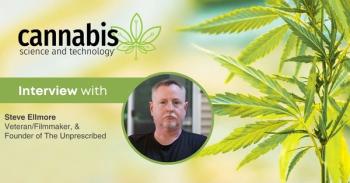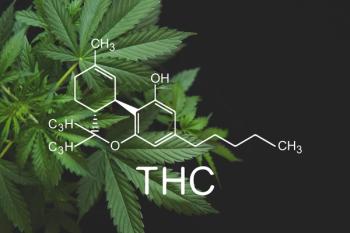
- March/April 2021
- Volume 2
- Issue 1
Cannabis as the Go-To Therapeutic: One Family’s Personal Journey of Discovery
Brendan McKernan and his father Richard found their way to medical cannabis almost as a last resort, but the plant became a turning point in their lives and careers that led to them down a road to help others.
More and more research in treating previously untreatable diseases and conditions is accelerating, in part because of new discoveries within certain plants such as cannabis, but also because of a general surge in life sciences research and discoveries.
A unique motivating factor happened in early 2020. It was in February that life sciences researchers were handed a significant challenge to find a vaccine for a deadly novel virus. In record time, British researchers found the first successful treatment for COVID-19: a cheap steroid dexamethasone. That treatment has been credited with saving 650,000 lives across the world, according to an article in The Economist (1), and came about because of genetic sequencing.
Today, genetic sequencing is being prioritized in laboratories across the world to track both variants and reinfections—a process that is spreading to other medical research as a result of the research into treatment for the virus. Even the cannabis genome has been sequenced.
In the cannabis world, new discoveries about what can and will soon be treated are also coming fast and furious. Cannabis has been proven effective for treating chronic pain, multiple sclerosis, epilepsy, and a host of other human maladies (2).
But what has really caught the attention of the medical community is the potential for cannabis to treat cancer. Ongoing studies are focusing on how cannabis can actually shrink tumors. It can be used successfully for treating the nausea that usually accompanies chemotherapy, and the anxiety of going through that process.
For example, recommended drugs to treat prostate cancer include abiraterone, an androgen biosynthesis inhibitor that works by decreasing the amount of certain hormones in the body (3). It comes with a long list of side effects, including confusion, vomiting, yellowing of the skin or eyes, swelling of the hands and feet, blood in the urine, and more.
Another drug is nilutamide, used after prostate surgery to stop the growth and spread of cancer cells. It can cause life-threatening lung disease (4).
Life sciences researchers following the “first, do no harm” creed of medicine are always in search of a way to avoid devastating side effects that could actually complicate cancer treatment by creating other health issues for the patient. That’s where cannabis comes in.
The McKernan Family Story
The McKernan family—brothers Brian, Brendan, and Kevin; sister Dr. Melissa McKernan-Pulliam (an electrophysiologist); and their parents Richard and Virginia—are life sciences explorers.
The brothers and their father helped build three major companies: Packard Bioscience, a scientific instrumentation company run by Richard, an electrical engineer who had designed avionics for military jets; Agencourt Bioscience, one of the largest commercial genomic services company in the US; and Agencourt Personal Genomics, which developed the SOLiD Next Generation Sequencing Platform that reduced the cost of genome sequencing by a factor of 100,000.
All three were acquired by major life science companies—Packard Biosciences was acquired by PerkinElmer in 2001, Agencourt Bioscience was acquired by Beckman Coulter, Inc. in 2005, and Agencourt Personal Genomics was acquired by Applied Biosystems in 2006.
Kevin McKernan stayed with Applied Biosystems after it acquired Agencourt Personal Genomics, working on worldwide sequencing development with another one of that company’s acquisitions, Ion Torrent.
Meanwhile, Brendan and older brother Brian formed Courtagen Life Science in 2010 to move genome sequencing into the clinic to help kids with epilepsy, autism, and mitochondrial disease. “We started seeing an overlap with the cannabis field because a number of doctors and physicians began asking about alternative therapies to help those kids,” said Brendan.
Kevin left Ion Torrent and formed Medicinal Genomics Corporation (MGC) in 2011, which was acquired by Brendan and Brian's company Courtagen Life Sciences in 2012 (5), and began working on sequencing the first cannabis genome after he was approached by a friend, who had lost multiple siblings to cancer at a relatively young age. Kevin began to explore genetic mutations and the potential treatment impacts of cannabis use. Beyond its commonly known ability to reduce nausea for chemotherapy patients, he uncovered significant evidence, born from scientists around the globe, exploring cannabis’ ability to reduce cancer cell proliferation and promote cell destruction. Now all three brothers were working at the same company. “Kevin was one of the first to sequence the cannabis genome, and he made it public for the world to use so we could start understanding and building a foundation for the cannabis plant,” said Brendan.
The brothers brought their father in as chairman of the board. After the legalization of medicinal cannabis in Massachusetts in 2016, MGC gained significant momentum to develop pioneering technology for growers that strengthens cannabis safety standards and increases productivity. But in 2017, all drivers of success for the brothers came to a grinding halt. Their dad, Richard, was diagnosed with stage four prostate cancer. The brothers then decided that it was time to reassess what they were doing, and potentially ramp up their work on using cannabis as a treatment option.
A Trailblazing Father
The devastating news of their father’s diagnosis caused a moment of reflection for the family, which actually accelerated their work. They took their father’s prostate genome and discovered a specific gene mutation that researchers said showed promise with various cannabinoids. “He had an mTOR and a BRAF mutation (6). These called for AKT inhibitors (which can reduce cancer cell growth), but there were none that had gone through the Food and Drug Administration,” said Brendan.
But there was a problem. Most of those AKT inhibitors were still in phase B clinical trials where researchers were working on the therapeutic efficacy of the inhibitors. “But if you happen to Google AKT 1 inhibitors in cannabinoids, you’ll find a bunch of scientific literature on its anti-neoplastic activity for the different cancer cell lines,” Brendan explained. “We eventually showed this data to my dad, who was very conservative. He didn’t really want to go on cannabis, he didn’t even drink alcohol. But after he looked at all the clinical literature, he agreed to try cannabis to help with his condition.”
Their father’s situation was turning dire. He lost about 50 pounds and was wasting away. “His cancer spread to his whole bone structure and he had tremendous pain and nausea,” Brendan said.
But the day he was given cannabis, he ate like a king. “His nausea went away. His bone pain went away. He had a nice, rosy feeling for the first time in a very long time,” Brendan commented.
He was kept on that cannabis-based therapy. The types of cannabinoids and different terpenes were adjusted.
Kevin made sure to test the purity of the cannabis before giving it to his father, eventually getting his company to invest in Pathoseek (7), a microbial detection system designed for testing cannabis flower, extracts, and infused products. He also worked on sequencing the genetics of cannabis strains to make sure they were getting the right compounds they wanted to use, and built the first public database called Kannapedia (8) that catalogs with genetic certainty the origins of thousands of cannabis strains and their relationships to other identified strains.
Eventually, a cocktail for their father’s therapy was found—a mixture of several cannabinoids: cannabigerol (CBG), cannabidiolic acid (CBDA), tetrahydrocannabinolic acid (THCA), tetrahydrocannabinol (THC), and cannabidiol (CBD). “We had a couple of different terpenes in there that had promise for prostate cancer,” Brendan said. “But it took us a good year to experiment with that.”
“We sought advice from leading experts in the field including Dr. Raphael Mechoulam, Dr. Bonni Goldstein, Dr. Dustin Sulak, Dr. Debra Kimless, and Mara Gordon. We experimented on everything from vaping to edibles to oils, and it turns out that we ended up using a combination of those things,” Brendan said. “The oils were great once we found the right combination, they would stay in his system for five or six hours before he would need his next dose.”
Their success in treating their father’s prostate cancer really turned heads. “The doctors at Dana-Farber/Brigham and Women’s Cancer Center in Boston were blown away that someone who had stage IV cancer was lasting this long and had no bone pain unless he was off of cannabinoids,” Brendan said. “That was absolutely amazing.”
When it came to allowing cannabis therapy, that hospital was the exception rather than the rule. Other medical systems in the Boston area were adamantly against it, Brendan explained, recalling how their father had to be rushed to an emergency room on occasion during the course of his illness. “He happened to end up at one particular hospital that became aware he was using cannabis,” he said. “They actually threatened to throw us out of the hospital and charge us for all of the bills as opposed to sending it to the health care insurance. They refused to allow us to give him cannabis at the hospital.”
He argued that their father was experiencing tremendous nausea when he was not taking cannabis. “Our family said ‘You guys have tried all the antiemetic drugs (anti-nausea drugs) that you have in stock and my father continues to throw up. He’s now throwing up all of his medication—the heart medication, and all the pain medication you’re putting him on. He cannot get comfortable. When we put him on cannabis, all that goes away, and you can continue treating him.’”
Fortunately, Brendan said, they had a wonderful nurse who helped. “She said ‘I know a lot of patients have gone to cannabis. I’ve seen how it can help patients. I’m going to walk out of this room, and you should probably do what you need to do to help your father. And don’t tell us anything’.”
Their father’s skepticism about cannabis changed as he went through the process, Brendan explained, so much so that he fundamentally believed at the end of his life that politicians opposing this drug should go to jail for holding these compounds back from patients. “My father just saw how beneficial they were to his own life. And for us to see the impact that cannabinoids had on my father’s life, and the fact that we, as a family, had the opportunity to spend four decent years with him before the last couple of months of his life where things really deteriorated.”
Richard lost his battle with prostate cancer on May 3, 2019 (9).
The Healthcare Promise of Genome Sequencing
The key to finding help for their father began with genome sequencing, a process that can identify the deoxyribonucleic acid (DNA) fingerprint of a germ, and is part of a broader movement in healthcare to do precision medicine (10).
What is genome sequencing and how does it work?
According to the National Human Genome Research Institute (11), a genome is an organism’s complete set of DNA, a chemical compound that contains the genetic instructions needed to develop and direct the activities of every organism. DNA molecules are made of two twisting, paired strands. Each strand is made of four chemical units, called nucleotide bases. The bases are adenine (A), thymine (T), guanine (G), and cytosine (C).
Bases on opposite strands pair specifically; an A always pairs with a T, and a C always with a G.
The human genome contains approximately 3 billion of these base pairs, which reside in the 23 pairs of chromosomes within the nucleus of all cells.
Each chromosome contains hundreds to thousands of genes, which carry the instructions for making proteins. Each of the estimated 30,000 genes in the human genome makes an average of three proteins.
“There’s a variety of different ways to sequence individuals,” Brendan said. “If you happen to go to a hospital for a seizure disorder, they might run a genetic test on you, which is a very targeted panel of maybe 100–400 different genes. There’s certain mutations that pre-dispose an individual to various types of seizure disorders.”
“If you happen to have something like my father’s BRAF mutation, we know those happen to have clinical literature supporting the use of AKT 1 inhibitors.
“But if you don’t know what’s wrong with a person, you may sequence their entire genome and look at all the genes associated with the body and then use an informatics platform to help interpret that data to see if you can associate clinical symptoms with various genetic mutations, and see if you can find the targeted therapy,” he said.
In 2012, Brendan had his own genome sequenced by Kevin to try to get at the root of an issue he was having with his heart—atrial fibrillation. He said that he went through a lot of traditional medicines at first, such as calcium channel blockers and beta blockers. “But I was falling asleep at work,” he said. “I was cloudy. My blood pressure was dropping dramatically along with my heart rate. I went back to the doctor and said: ‘Look, I can’t take these prescribed medicines anymore because I can’t operate or live my life.’”
The sequencing revealed a series of calcium channel mutations. Those mutations are believed to be causing Brendan’s arrhythmias due to calcium leaks. After extensive research, Kevin found a series of studies related to CBD’s roll in buffering calcium levels in the mitochondria, posing the question: Is it plausible to say that perhaps compounds in the cannabis plant may help improve his condition? “Some doctors thought it was worth a try and they thought it was relatively low risk,” he said. “I went on to cannabinoids and lo and behold, my rhythm disorders, for the most part, went away.”
Brendan was quick to point out that his case is just one example and a lot of research has to be done to prove that this is not a private mutation relative to the rest of the population. It has to be studied. "Hundreds to thousands of different genetic defects can likely all share the common phenotype of arrhythmias. My experience does not support the use of CBD for any arrhythmia. My successful treatment is likely specific to my private case of calcium channel mutations and caution is advised extending this treatment to any person with the relatively vague descriptor of having 'arrhythmias,'" he explained. "The other plausible scenario is that certain cannabinoids also help regulate stress levels in the body and stress is known to trigger for arrhythmias as are things like caffeine and alcohol. I have removed virtually all those other components to my diet as well. I haven't been back to the hospital since.".
Brendan explained that he takes a combination much like his father was on: typically CBD, CBDA, CBG, and on occasion, THC as well. "It's probably closer to a four to one ratio of the non-psychoactive components to the psychoactive component," he added.
"I have also lived with chronic pain as long as I can remember. I, for the most part, have pain every day. It's a mixture of very sharp stabbing pains in my back to numbness and pins and needles in my leg. And occasionally the leg feels like it's filling up with hot water. That's the typical feeling I had for many years," said Brendan. "The cannabis has dramatically dulled that pain. Some days I don't have pain at all, which amazes me because I went for decades having pain on a daily basis. On average, it doesn't eliminate all of the pain all of the time. But it's gotten to the point where I can live my life and I'm not thinking about the pain all the time."
Perhaps even more astounding is that Brendan has completely come off all pharmaceutical drugs. "I have eliminated 100% of all other pharmaceuticals," he said. "Cannabinoids are the only things I take outside of vitamins and supplements, and that's it."
These personal experiences with medical cannabis became an “ah-ha” moment for the brothers. Brendan explained that he and his brother Kevin want to enable the industry to better understand the genetics of the plant and its impact on human health.
There’s a lot more work to do to sequence and annotate the plant, interpret all the genes, and put that into a meaningful clinical context to better help patients, Brendan said. “But the industry is moving in that direction.”
In 2017, Kevin participated in one of the first studies (12) on rare genetic variants in core endocannabinoid system genes that was identified in 6032 patients with a broad spectrum of neurological disorders.
Educating the Masses
The McKernan family’s unique story about their father, and Brendan’s experience with treating his own issues, resonates throughout the medical cannabis community. The brothers had unique tools available to them that not only led to advanced diagnosis and therapeutics, but served as a framework for further research.
“When we see a problem in our family, at least we sequence our genome to see what we could find,” Brendan said. “What do the genes tell us and where does that send us? One could call it a rabbit hole of digging into all the research to figure out if there is data to support a hypothesis about particular compounds that may help with a specific condition. Our experience solidified our belief that we need to drive science and medicine in this field to help a lot more patients.”
As a result of that desire, the leadership team at MGC founded the CannMed Conference Series, whose mission is to bring together the world’s leading cannabis experts to share their findings and latest research. In late 2015, MGC partnered with Dr. Raphael Mechoulam and hosted the inaugural CannMed Conference at Boston’s Harvard Medical School in April 2016. The CannMed Cannabis Conference now gathers the brightest minds in the cannabis industry worldwide to help further cannabis research, advance breeding techniques, and discuss advances in laboratory safety. In just two years, the conference size outgrew the venue at Harvard University, and moved to the West coast where they will host the fifth annual gathering at the Pasadena Convention Center in September 2021. This year, CannMed will include an 8-hour Medical Practicum, where attendees can learn the practical guidelines of cannabinoid therapeutics and research, from medical leaders in the industry (13).
Looking to the Future
Brendan believes that regulations need to change to keep the cannabis industry moving forward in the right direction. "It needs to start, unfortunately, with the federal government changing its position, especially since they have, in fact, patents and approved drugs that are based off of cannabinoids even though it’s still a Schedule 1 drug. It just doesn’t make any sense now,” he said.
In looking back on the experience with his father, and all that the family went through fighting against the stigma of the plant while employing a deeper understanding of both the cannabis and human genome, Brendan struck a note of hope going forward. “It’s an intriguing field,” he said. “Ten years ago, I would never have thought or told people I would be in the cannabis space. Now I can’t envision being in any other industry because I think our particular sector, with the 900-plus compounds in the plant, is going to, over time, develop the biggest pharmaceutical library our healthcare system has seen in decades.
“There’s so many active compounds in this plant. Once we unravel them and figure out what conditions they can be applied to, I think you’re going to see improvements for diseases associated with the central nervous system, safer alternatives for chronic pain and certainly palliative benefits for those dealing with cancer.”
There are cannabis doctors and scientists who are exploring the potential of cannabis being used in cancer treatment, such as Dr. Bonni Goldstein, Dr. Dustin Sulak, and Dr. Ethan Russo (14), all of whom are presenting at the 2021 CannMed Conference September 29-October 1, 2021 (15).
Brendan noted that this conference was just one of many ways in which scientists and researchers are coming together to study cannabis and how it can help treat various human conditions. “We’re just standing on other people’s shoulders and trying to carry that torch forward to educate the world and make a difference,” he said.
References
https://www.economist.com/britain/2021/02/27/how-british-science-came-to-the-rescue .https://www.ncbi.nlm.nih.gov/books/NBK425767/ .https://medlineplus.gov/druginfo/meds/a611046.html .https://medlineplus.gov/druginfo/meds/a697044.html .https://www.genomeweb.com/molecular-diagnostics/courtagen-closes-genetic-testing-business-citing-regulatory-reimbursement#.YEqnHRiZPBI .https://academic.oup.com/jcem/article/97/7/E1139/2833320 .https://www.medicinalgenomics.com/pathoseek-id/ .https://www.kannapedia.net .https://www.courant.com/obituaries/hc-obituary-richard-t-mckernan-20190529-story.html .https://www.cdc.gov/genomics/about/precision_med.htm .https://www.genome.gov/human-genome-project/Completion-FAQ .https://www.ncbi.nlm.nih.gov/pmc/articles/PMC5690672/ .https://cannmedevents.com/practicum/ .http://cannmedevents.com/practicum/#speakers .https://cannmedevents.com
Articles in this issue
over 4 years ago
March/April 2021 Digital Editionover 4 years ago
Cannabis and Chronic Pain: A New Frontier?over 4 years ago
The Pain Dilemma: Cannabis Versus Medicine?over 4 years ago
The Path of a Chronic Pain CaregiverNewsletter
Unlock the latest breakthroughs in cannabis science—subscribe now to get expert insights, research, and industry updates delivered to your inbox.




